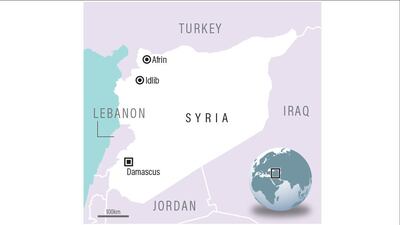US President Donald Trump has vowed that missiles would be launched at Syria following a suspected chemical attack, virtually ensuring a military strike against the regime of President Bashar Al Assad.
The question now becomes what the United States, probably with France and Britain, will hit in Syria, and what are the risks of escalation and miscalculation with Mr Al Assad's allies Russia and Iran.
President Al Assad said on Thursday that Western threats to strike Syria are based on "lies" and seek to undermine the country's military reported capture of Eastern Ghouta.
Mr Al Assad said that Western threats endanger international peace and security, and that military action would only contribute to the "further destabilisation" of the region.
What will be targeted?
The United States and its allies France and Britain want to send a clear and definitive message to that the future use of chemical weapons will not be tolerated.
One way to ensure Al Assad cannot use such weapons is to conduct strikes on his chemical infrastructure, including by targeting factories and weapons holding areas.
Such an action carries risks, including the possibility of unintentionally unleashing a cloud of toxic gas into the environment.
The strike could also target what is left of Al Assad's air force and air defences, though the delay between Saturday's attack and an eventual retaliatory strike means he likely will have moved his warplanes to safety.
Jennifer Cafarella, a Syria analyst for the Washington-based Institute for the Study of War, said one potential target would be Dumayr military airport northeast of Damascus, from where regime aircraft used in Saturday's attack may have launched.
___________
Read more:
White House: no final decision has been made on Syria
The chemical weapons attack is a critical moment to push for a political settlement in Syria
Trump to Russia: US missiles ‘coming’ to Syria
___________
Moscow has two air bases on the Syrian coast, Tartus and Hmeimim, protected by S-300 and S-400 air missile defence systems.
How big will the strike be?
Mr Trump last year ordered a strike against the Assad regime following a deadly sarin gas attack on the rebel-held town of Khan Sheikhun.
The US Navy launched 59 Tomahawk cruise missiles from destroyers in the eastern Mediterranean, targeting Shayrat air base, its aircraft, ammunition supply bunkers, air defence systems and radar systems.
But the strike was limited and designed to not draw America into the chaos of Syria's bloody civil war.
Since then, the Al Assad regime is alleged to have repeatedly used chlorine and other chemicals, forcing Pentagon planners to consider broader action.
Cafarella said the United States must decide how far it wants to go in terms of hitting Iranian proxy forces near US positions in eastern Syria, or even targeting Russian-supported facilities.
"The president has publicly stated that he intends to hold not just Assad but his backers accountable as well," she said.
How will action be launched?
A strike against Syria will likely come in the form of missiles, as was the case last year.
The United States would not want to risk putting manned fighters over Syrian air defences - a shoot-down would send the conflict spiraling in unforeseeable new directions.
The USS Donald Cook, an Arleigh Burke-class guided-missile destroyer, is within easy striking range of Syria, as is a French frigate with its own cruise missiles.
These two ships, possibly aided by a US submarine, are likely to play a role in a strike.
The US also has B-2 bombers at its disposal. These stealth planes were used in 2017 against the Islamic State group in Libya, having flown all the way from America on a 34-hour round trip.

What are the risks?
The reaction from Russia is unpredictable and Moscow has threatened retaliatory action against the United States if missiles are fired at Syria.
The Russian army on Wednesday accused the White Helmets civil defence organisation of staging a chemical weapons attack in Douma, where observers say more than 40 people died in a gas attack.
NBC News reported on Tuesday that Russia has learned how to use GPS jammers to limit the capabilities of US drones operating over Syria.
"The US has to be very careful not to accidentally strike Russian targets or kill Russian advisers," said Ben Connable, a senior political scientist at the RAND Corporation.
"That significantly limits the number of options available to the United States, because the Russians are embedded in many cases with the Syrians."
Mr Connable warned that if the US accidentally or purposefully kills uniformed Russian soldiers, there would potentially be a dangerous escalation between the two nuclear powers.



